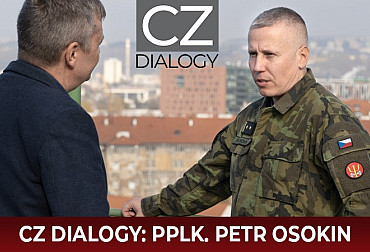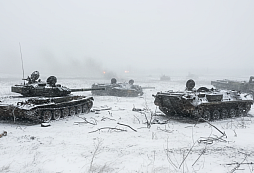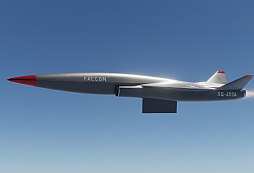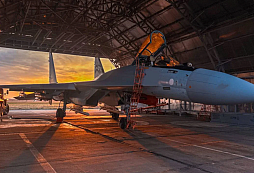Gen. Petr Milčický: All key projects are on schedule, Pandurs await military recommendation
The Force Development Section of the Ministry of Defence is one of the key parts of the Army. Its director is Brigadier General Petr Milčický, who is directly subordinate to the Chief of the General Staff of the Army of the Czech Republic. He is responsible for conceptual activities and for the professional and methodical management of the command and control system. He is responsible for setting principles and standards in the field of joint training of ground forces and air forces, rescue and airborne services, search and rescue services in the Army of the Czech Republic. General Milčický served for three years within the North Atlantic Alliance structures at the NATO International Headquarters as the Director of Strategic Planning and Force Development Liaison at ACT (Allied Command Transformation) Norfolk. In the next episode of our CZ DIALOGUES programme we had the opportunity to talk to one of the most authoritative experts on the current state of modernisation of the Czech Army, including the development of its ground and air forces.
Video: Interview with the Director of the Force Development Section of the Ministry of Defence, Brig. Gen. Petr Milčický / CZ DEFENCE
At the very beginning of the interview, General Milčický appreciated the high operational pace of modernisation, which our army has never seen before. And if, according to him, there are minor delays somewhere, it is mostly caused by bureaucratic steps that were not foreseen or not implemented in time. "I rate it as excellent, high-paced, well-planned," says the director of the Defence Ministry's Force Development Section.
The Force Development Section is not just responsible for ground and air forces. It has a total of four development areas in its portfolio. "It is the development of ground forces, the development of air forces, the development of cyber forces and information operations, and it is responsible to the Chief of the General Staff for the development of the entire army's preparation for warfare," General Milčický specifies. The actual planning then happens essentially in three horizons. "The first horizon is a kind of elaboration of the vision of future warfare, which we even released to the world under the leadership of the Chief of General Staff General Rehka in the form of the document Vision of Future Warfare for the 2040 horizon," explains Gen. Milčický. According to him, the meaning of this document is that it elaborates the requirements for future warfare in such a way that the army will be able to implement them in the short term, which is elaborated in terms of the task in the Concept of the Construction of the Army of the Czech Republic until 2035. This will then be worked out in the short term, about two to four years in the form of individual projects. "And we will write this into the concepts of development of individual types of forces, which are the responsibility of the Force Development Section," Gen. Milčický.
The development of individual types of forces also means the ability to plan and conduct operations in given operational domains. In the future, the new Alliance concept foresees that the Alliance will have to be able to plan and conduct operations in a so-called multi-domain environment. "This means conducting operations in all five operational domains and two operational environments simultaneously. This is a very significant task that must be very well planned and well ahead of time. It has to be worked out so that when we buy weapons systems or communications technology, we are always one step ahead and know what we will need in the future," says the Director of the Force Development Section of the Ministry of Defence.
The concept of force development is influenced not only by the changing global security situation, but also by its dynamics. "All the changes that are happening on a global or local scale, and for which we are preparing, have a big impact on future requirements and warfighting capabilities. Specifically, the security environment doesn't have such an immediate impact on the major weapon systems that are key to the maneuver elements," the general says, adding that he is referring to the Army's key projects such as the F-35 aircraft, the NATO gun or the acquisition of the main battle tank.
Something else, according to General Milčický, are changes in the technological field. "A typical example is breakthrough technologies that are being implemented very intensively in the military. At the moment, we need to be able to work with that as well, so that we have a long-term strategy for how we will implement breakthrough technologies in general into our doctrines, and at the same time how we will implement each breakthrough technology gradually into the weapon systems that we have already acquired and that we intend to acquire," the general points out.
Further, in our conversation with General Milčický, we wondered how such a force development process is being created by the Army? "First of all, the Army of the Czech Republic, as one of the members of the North Atlantic Alliance, has three basic tasks established by the Armed Forces Act 219/1999 Coll. The first one is to be able to secure the defence of the Czech Republic. The second is to be able to support the other branches of the Czech government, including the integrated rescue system. And the third task is to be able to act within the Alliance," explains Gen. "We, as an army, when we put forward requirements for the weapon systems we need to achieve capabilities and perform these kinds of tasks, we cannot look at financial resources in that first line of planning. We have to be able to define the required capabilities that we need. Subsequently, this military recommendation is presented to the political leadership of the Department of Defense, and subsequently to the government," said the director of the Force Development Section of the Ministry of Defense. The Czech government then approves all major projects above CZK 300 million and, according to General Milčický, it is only at this stage that the prioritisation of what will be implemented now and later takes place.
During our interview with the Director of the Force Development Section of the Ministry of Defence, we also took a small inventory of where the modernisation projects currently stand. According to General Milčický, the F-35 project, the CV90 tracked combat vehicle, the Caesar gun or the SPYDER missile system, and some other projects are running on schedule. "For the projects already contracted, a very detailed and detailed schedule for delivery, subsequent implementation and introduction into use within the Czech Army has been drawn up. The schedule is regularly checked, at least once a month. All projects are subject to department-wide discussions across the MoD sections, as each of the projects must meet the Alliance methodology. There are eight requirements, which start with the 'D', which are the doctrinal requirements, and end with the 'E', which are the interoperability requirements, or the requirements for integration and connectivity within the command and control system," General Milčický explained.
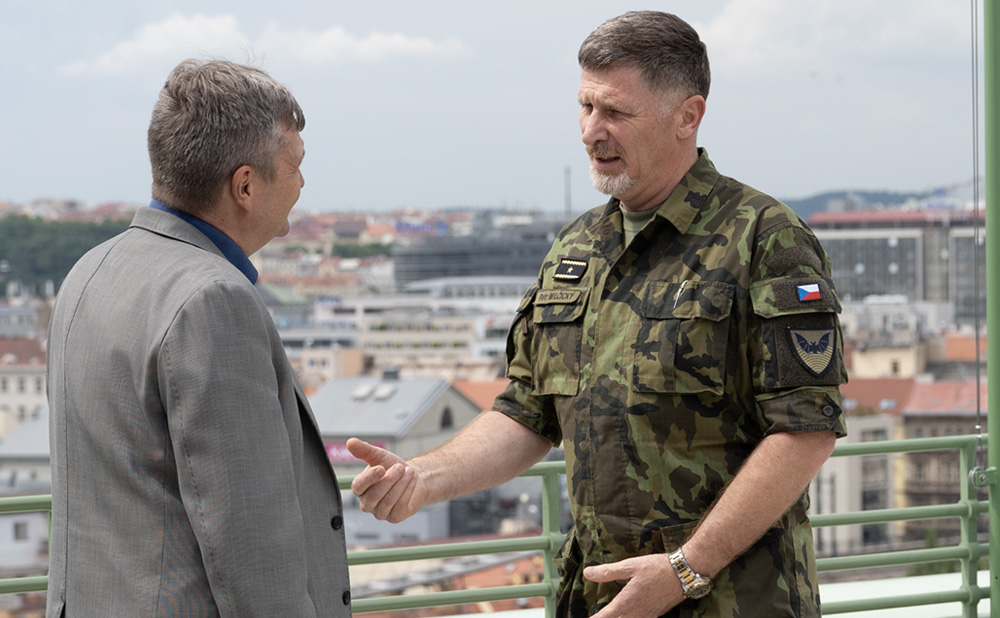
According to the Director of the Force Development Section of the Ministry of Defence, the massive construction of infrastructure for the F-35 aircraft is not a complication. In this case, according to Gen. Milčický, it was important to take advantage of the preparatory phase before signing the contract and to have all the information and analyses that revealed the extent of changes and modifications in case of signing. "After the contract was signed, a very detailed plan and schedule of activities was then developed so that we were able to secure everything. We received another package of information from the United States as the contract was signed. Now the most complicated thing at the moment is checking the schedule for the construction of the infrastructure at the air base in Čáslav, which we have to check almost daily. The second part, which is related to this, is the management and handling of classified information. The real infrastructure also counts on that," says General Milčický.
Similarly, according to him, preparations are underway for the takeover of the CAESAR guns, which our artillerymen will receive in 2026. Everything must then be prepared so that the army can implement and use them at the beginning of 2027, when additional guns will be gradually introduced into the army, up to a total package of sixty-two units.
During our recent visit to the 4th Rapid Deployment Brigade in Žatec, we discussed with its commander, General Líbal, among other things, the need to modernise and purchase additional Pandur 8x8 vehicles to rearm the brigade. We also discussed this topic with General Milčický. "You are right that there are two requirements. We are in the middle of the life cycle and current armament of the Pandur 8x8. We need to modernize it in many aspects and at the same time we need to arm one battalion of the 4th Rapid Deployment Brigade with this system. We expected, as planned, to receive a feasibility study, which we asked the Armaments and Acquisition Section to do. It was not ultimately implemented. We have received the information from the market consultations with the manufacturer, and we are now processing that. We will then prepare military recommendations and material on how to proceed with this project," Gen. Milčický.
Current battlefield experience, among other things, points to the advantages of the all-military nature of the units. However, within the manoeuvre elements of the Army of the Czech Republic, neither the 4th Rapid Deployment Brigade nor the 7th Mechanised Brigade has such capabilities, so we were interested to know whether this capability is envisaged in our army in the future. "It is not, because the Army of the Czech Republic has decided in the long term to take a different path and it is anchored in the doctrine of the Army of the Czech Republic. Three years ago we incorporated it into a completely newly created doctrine of operational training of the Army of the Czech Republic and we speak everywhere that we understand the involvement of the forces and means of the Army of the Czech Republic in any operation at the level of tactical elements of the manoeuvre type at the brigade level. We expect that we will always send purpose-built task groups to a planned operation. They can be platoon, company, battalion and brigade. If it is an operation in which high-intensity combat is expected and we will be stopping one of the brigades of the Czech Army - the fourth or seventh, we will create such a robust task force that all the elements necessary for the conduct of combat will be provided in the task force," said Brigadier General Petr Milčický, Director of the Force Development Section of the Ministry of Defence.

If you are wondering about the further development of new technologies in our military, the training of soldiers or the need for self-sufficiency of our country in the case of building defence and security, listen to the full interview at the beginning of this article.
















